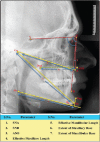Diagnostic features of Angle's Class II div 2 malocclusion
- PMID: 26759807
- PMCID: PMC4697238
- DOI: 10.4103/2231-0762.170528
Diagnostic features of Angle's Class II div 2 malocclusion
Abstract
Statement of problem: A thorough knowledge of the salient features of malocclusion makes the practitioner to come to a proper diagnosis and to formulate proper mechanotherapy. It also helps to predict the prognosis, prior to the onset of treatment process. Among the various malocclusions, Class II div 2 occurs the least often. The literature review does not clearly describe the classical skeletal and dental features of Angle's Class II div 2 malocclusion.
Purpose of study: The aim of this study is to describe the unique features of Angle's Class II division 2 malocclusion.
Materials and methods: A total of 612 pre-treatment records (study models and cephalograms), with age ranging from 14 to 25 years, were obtained from the hospital records of Drs Sudha and Nageswar Rao Siddhartha Institute of Dental Sciences. Among these samples, 317 were Class II div 1 and 295 were Class II div 2. The lateral cephalograms were analyzed by using Kodak software and the arch width analysis was calculated by using digital vernier calipers.
Results: Student's t test was used for the study. On the cephalograms, the vertical skeletal measurements and few of the dental variables showed a significant difference. On the plaster models, the maxillary transverse measurements revealed a notable discrimination between the groups.
Conclusion: Angle's Class II div 2 malocclusion has a marked horizontal growth pattern with decreased lower facial thirds, palatally inclined upper anteriors, and remarkably increased transverse maxillary arch dimensions.
Keywords: Class II div 2; facial height; growth pattern; malocclusion.
Figures






References
-
- Moorrees CF, Grøn AM, Lebret LM, Yen PK, Fröhlich FJ. Growth studies of the dentition: A review. Am J Orthod. 1969;55:600–16. - PubMed
-
- Buschang PH, Stroud J, Alexander RG. Differences in dental arch morphology among adult females with untreated Class I and Class II malocclusion. Eur J Orthod. 1994;16:47–52. - PubMed
-
- Walkow TM, Peck S. Dental arch width in Class II Division 2 deep-bite malocclusion. Am J Orthod Dentofacial Orthop. 2002;122:608–13. - PubMed
-
- Pancherz H, Zeiber K, Hoyer B. Cephalometric characterisitcs of Class II division 1 and Class II division 2 malocclusions: A comparative study in children. Angle Orhtod. 1997;67:111–20. - PubMed
-
- Blair ES. A cephalometric roentgenographic appraisal of the skeletal morphology of Class I, Class II, Div.1, and Class II, Div. 2 (Angle) malocclusions. Angle Orthod. 1954;24:106–19.
LinkOut - more resources
Full Text Sources
Other Literature Sources
Research Materials

